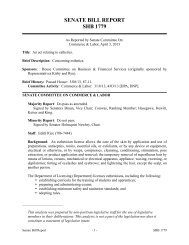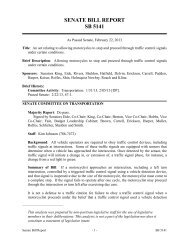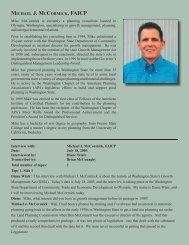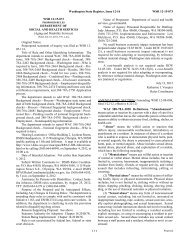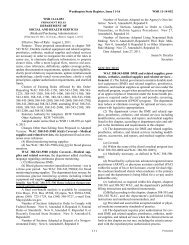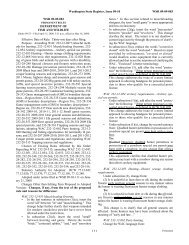Proposed
Proposed
Proposed
You also want an ePaper? Increase the reach of your titles
YUMPU automatically turns print PDFs into web optimized ePapers that Google loves.
WSR 12-21-103 Washington State Register, Issue 12-21<br />
Exceptions:<br />
(a) For an owner, an electrical work permit for emergency<br />
repairs to an existing electrical system(s) must be<br />
obtained ((and posted at the job site)) no later than the next<br />
business day after the work is begun.<br />
(b) For an electrical contractor, in a city's jurisdiction<br />
where the city is authorized to do electrical inspections and<br />
does not have a provisional ((and a Class B)) permit system,<br />
an electrical work permit for emergency repairs to an existing<br />
electrical system(s) must be obtained and posted, per the<br />
city's requirements at the job site no later than the next business<br />
day after the work is begun.<br />
(((7))) (6) Fees must be paid in accordance with the<br />
inspection fee schedule in Part C of this chapter. The amount<br />
of the fee due is calculated based on the fee effective at the<br />
date payment is made. If the project is required to have an<br />
electrical plan review, the plan review fees will be based on<br />
the fees effective at the date the plans are received by the<br />
department for review. In a city where the department is<br />
doing inspections as the city's contractor, a supplemental fee<br />
may apply.<br />
Permit - Requirements for.<br />
(((8))) (7) As required by chapter 19.28 RCW or this<br />
chapter, an electrical work permit is required for the installation,<br />
alteration, or maintenance of all electrical systems or<br />
equipment except for:<br />
(a) Travel trailers;<br />
(b) Class A basic electrical work which includes:<br />
(i) The like-in-kind replacement of ((a:)) lamps; a single<br />
set of fuses; a single battery smaller than 150 amp hour;<br />
contactors, relays, timers, starters, circuit boards, or similar<br />
control components; one household appliance; circuit breakers;<br />
((fuse;)) single-family residential luminaires; ((lamp;))<br />
up to five snap ((switch;)) switches, dimmers((;)), receptacle<br />
outlets((;)), thermostats((;)), heating elements((;)), luminaire<br />
ballasts with an exact same ballast; component(s) of electric<br />
signs, outline lighting, or skeleton neon tubing when replaced<br />
on-site by an appropriate electrical contractor and when the<br />
sign, outline lighting or skeleton neon tubing electrical system<br />
is not modified; one ten horsepower or smaller<br />
motor((;)).<br />
For the purposes of this section, "circuit breaker" means<br />
a circuit breaker that is used to provide overcurrent protection<br />
only for a branch circuit, as defined in NEC 100.<br />
(ii) Induction detection loops described in WAC 296-<br />
46B-300(2) and used to control gate access devices;<br />
(iii) Heat cable repair; and<br />
(iv) Embedding premanufactured heat mats in tile grout<br />
where the mat is listed by an approved testing laboratory and<br />
comes from the manufacturer with preconnected lead-in conductors.<br />
All listing marks and lead-in conductor labels must<br />
be left intact and visible for evaluation and inspection by the<br />
installing electrician and the electrical inspector.<br />
Unless specifically noted, the exemptions listed do not<br />
include: The replacement of an equipment unit, assembly, or<br />
enclosure that contains an exempted component or combination<br />
of components (e.g., an electrical furnace/heat pump,<br />
industrial milling machine, etc.) or any appliance/equipment<br />
described in this section for Class B permits.<br />
<strong>Proposed</strong> [ 56 ]<br />
In the department's jurisdiction, a provisional electrical<br />
work permit label may be posted in lieu of an electrical work<br />
permit. If a provisional electrical work permit label is used,<br />
an electrical work permit must be obtained within two working<br />
days after posting the provisional electrical work permit<br />
label. See WAC 296-46B-907(2) for provisional label<br />
requirements.<br />
(((9))) (c) The following types of systems and circuits<br />
are considered exempt from the requirements for licensing<br />
and permitting described in chapter 19.28 RCW. The electrical<br />
failure of these systems does not inherently or functionally<br />
compromise safety to life or property.<br />
(i) Low-voltage thermocouple derived circuits;<br />
(ii) Low-voltage circuits for built-in residential vacuum<br />
systems;<br />
(iii) Low-voltage circuits for underground landscape<br />
sprinkler systems;<br />
(iv) Low-voltage circuits for underground landscape<br />
lighting; and<br />
(v) Low-voltage circuits for residential garage doors.<br />
For these types of systems and circuits to be considered<br />
exempt, the following conditions must be met:<br />
(A) The power supplying the installation must be derived<br />
from a listed Class 2 power supply;<br />
(B) The installation and termination of line voltage<br />
equipment and conductors supplying these systems is performed<br />
by appropriately licensed and certified electrical contractors<br />
and electricians;<br />
(C) The conductors of these systems do not pass through<br />
fire-rated walls, fire-rated ceilings or fire-rated floors in other<br />
than residential units; and<br />
(D) Conductors or luminaires are not installed in installations<br />
covered by the scope of Article 680 NEC (swimming<br />
pools, fountains, and similar installations).<br />
(8) An electrical work permit is required for all installations<br />
of telecommunications systems on the customer side of<br />
the network demarcation point for projects greater than ten<br />
telecommunications outlets. All backbone installations<br />
regardless of size and all telecommunications cable or equipment<br />
installations involving penetrations of fire barriers or<br />
passing through hazardous locations require permits and<br />
inspections. For the purposes of determining the inspection<br />
threshold for telecommunications projects greater than ten<br />
outlets, the following will apply:<br />
(a) An outlet is the combination of jacks and mounting<br />
hardware for those jacks, along with the associated cable and<br />
telecommunications closet terminations, that serve one workstation.<br />
In counting outlets to determine the inspection<br />
threshold, one outlet must not be associated with more than<br />
six standard four-pair cables or more than one twenty-fivepair<br />
cable. Therefore, installations of greater than sixty standard<br />
four-pair cables or ten standard twenty-five-pair cables<br />
require permits and inspections. (It is not the intent of the<br />
statute to allow large masses of cables to be run to workstations<br />
or spaces serving telecommunications equipment without<br />
inspection. Proper cable support and proper loading of<br />
building structural elements are safety concerns. When considering<br />
total associated cables, the telecommunications<br />
availability at one workstation may count as more than one<br />
outlet.)



